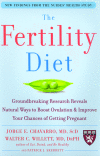Written for the lay reader, The fertility diet explicates data from the long-standing Nurses’ Health Study (and related other work) on the impact of food intake and, to a lesser degree, other lifestyle variables on infertility secondary to ovulatory dysfunction. The authors are Jorge E. Chavarro, a research fellow at the Harvard School of Public Health; Walter C. Willett, chairman of the Department of Nutrition at the same institution; and Patrick J. Skerrett, contributor to Willett’s Eat, drink, and be healthy (1). While the main focus of The fertility diet is diet, the book covers several other topics, such as the facts of life, which segues into the causes of infertility. The final chapters are devoted to exercise, a brief description of study methodology (a nice inclusion for a general audience, with a frank appraisal of the kinds of questions these types of studies can and cannot answer), and a week’s worth of recipes that fit the dietary guidelines set forth in the book. Overall, this is an entertaining read with a clear message delivered with a light touch. There is not a white coat or church pulpit in sight.
The solid middle sections of the book are devoted to what mothers-to-be — and everyone else — should eat and drink. A summary of general dietary considerations is followed by chapters on good and bad carbohydrates (“slow” and “low,” respectively), fats (avoid trans fats and severely limit intake of the saturated kind), the virtues of plant proteins, the importance of micronutrients, the benefits of low-sugar beverages, and weight recommendations (the “fertility zone”). For the most part, these sections are written in a very approachable way. References to data from the Nurses’ Health Study, along with other pertinent citations, are used sparingly. On some topics there are lots of data, such as the possible ill effects of moderate alcohol consumption on fertility and pregnancy outcome, although clear conclusions are absent because they are not yet warranted. The authors have compiled a great deal of reliably sourced information on a broad range of topics that would be difficult for those outside the field to gather individually. The target audience is first-time, would-be mothers and women diagnosed with an ovulatory disorder, but anyone who heeds the authors’ advice will likely be the better for it. In a time when our food choices are killing us faster than the response time of the medical establishment and the pharmaceutical industry, the authors’ sensible approach to diet is critically important. This book could influence the eating and exercise habits of not only women, but also their families. It is meant to be a crossover book that could affect the entire family, and I think that it does this job admirably.
But as a scientist, I asked myself, “Will the lifestyle targets set forth in this book cure infertility, the logical conclusion that the title implies?” The answer is a resounding “Yes, but . . . .” The most promising recommendations apply to only a small subset of infertile women — those with ovulatory dysfunction. This fact is not made clear on the book jacket, which proclaims that “. . . women in the [Nurses’ Health Study] who followed three or four of the recommendations suggested in The fertility diet were 66% less likely to have problems conceiving than women who didn’t.” While this is an accurate description of the study results, in many cases there is no clear cause and effect, a fact that the authors, to their credit, clearly state in the smaller font of the actual text. I found that the study results raised more questions than they answered, a personal perspective that is directly attributable to my predilection as a basic scientist for framing questions that can be answered in more concrete terms. Another downside is that there is little information presented that has not been widely covered in the lay press. For example, most women seeking infertility treatments are likely to know already that very low and very high body mass indices are associated with ovulatory failure.
On the other hand, as a wife and mother, I found this book fun to read. It’s well written and good-hearted, with easy-to-decipher figures and tables. I suspect it will appeal to those readers about to embark on the journey toward motherhood or are afraid that they have already missed the boat. The take-home lessons are summarized in many places for those who skim rather than read from cover to cover, but readers outside the fields of medicine and science will appreciate the repetition. Some parts of the book are surprisingly well done. As an avid cook, I liked that many of the recipes include sophisticated blends of healthy ingredients and spices in tasty combinations. I would recommend this book for the small subset of women who are having difficulty conceiving because of irregular menses due to oligoovulation or anovulation, as well as for those seeking an entertaining tour of the modern landscape of diet and exercise, albeit through the lens of pregnancy.
References
- 1. Willett, W.C. 2001.Eat, drink, and be healthy: the Harvard Medical School guide to healthy eating. Simon & Schuster Inc. New York, New York, USA. 304 pp [Google Scholar]



